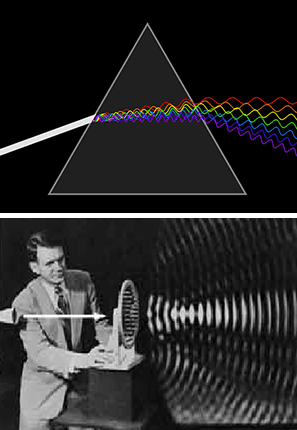
Summary
Students are provided with an understanding of sound and light waves through a "sunken treasure" theme—a continuous storyline throughout the lessons. In the first five lessons, students learn about sound, and in the rest of the lessons, they explore light concepts. To begin, students are introduced to the concepts of longitudinal and transverse waves. Then they learn about wavelength and amplitude in transverse waves. In the third lesson, students learn about sound through the introduction of frequency and how it applies to musical sounds. Next, they learn all about echolocation—what it is and how engineers use it to "see" things in the dark or deep underwater. The last of the five sound lessons introduces acoustics; students learn how different materials reflect and absorb sound.Engineering Connection
Engineers create new things for the benefit of society; they apply their understanding of the science of sound and light waves to the invention and evolution of many devices and products used daily for improved living, safety or prevention of harm. Sonar, reading glasses, light bulbs, stereo equipment and lasers, are just a few of the many items that engineers are involved in designing. To develop the technologies necessary to create these items, engineers must thoroughly understand how sound and light waves work, as well as wavelengths and amplitudes of waves. For example, engineers design vessels that travel on ocean waves and tsunami detection devices to warn people of approaching danger.
Engineers apply their understanding of frequencies to design many commonly used items such as lights, televisions and even traffic signals. Frequency is an important aspect of music; notes with different frequencies make different sounds. Acoustic engineers help to design theatres and auditoriums in order to optimize the sounds produced on stage for the benefit of the audience.
Being able to see is crucial for many everyday tasks. Engineers have developed electricity and lighting to help us see in the dark. Lighting engineers design the lighting systems where we live and work, customizing them for specific needs and conditions.
The list of how engineers apply their understanding of waves goes on and on, such as the use of electromagnetic waves in gamma radiation emitted by fuel rods in nuclear power plants, x-rays to peer inside our bodies, ultraviolet light for sanitation, microwaves for cooking, and radio waves to communicate over large distances.
Educational Standards
Each TeachEngineering lesson or activity is correlated to one or more K-12 science,
technology, engineering or math (STEM) educational standards.
All 100,000+ K-12 STEM standards covered in TeachEngineering are collected, maintained and packaged by the Achievement Standards Network (ASN),
a project of D2L (www.achievementstandards.org).
In the ASN, standards are hierarchically structured: first by source; e.g., by state; within source by type; e.g., science or mathematics;
within type by subtype, then by grade, etc.
Each TeachEngineering lesson or activity is correlated to one or more K-12 science, technology, engineering or math (STEM) educational standards.
All 100,000+ K-12 STEM standards covered in TeachEngineering are collected, maintained and packaged by the Achievement Standards Network (ASN), a project of D2L (www.achievementstandards.org).
In the ASN, standards are hierarchically structured: first by source; e.g., by state; within source by type; e.g., science or mathematics; within type by subtype, then by grade, etc.
See individual lessons and activities for standards alignment.
Subscribe
Get the inside scoop on all things TeachEngineering such as new site features, curriculum updates, video releases, and more by signing up for our newsletter!Unit Schedule
- Day 1: Surf's Up! lesson and Make Some Waves activity
- Day 2: Checking the Surf lesson
- Day 3: Simon Says Big Amplitude, Small Wavelength! activity
- Day 4: Making Music lesson and Simple Instruments activity
- Day 5: Plumbing the Deep - Using Sound Waves to See lesson and Echolocation in Action! activity
- Day 6: To Absorb or Reflect... That is the Question lesson and Controlling Sound activity
- Day 7: Needing Illumination – Investigating Light lesson and Light Scavengers activity
- Day 8: Visible Light and the Electromagnetic Spectrum lesson
- Day 9: The Visual Spectrum activity
- Day 10: Building a Fancy Spectrograph activity
- Day 11: Pictures Please – Traveling Light lesson and Create a Pinhole Camera activity
More Curriculum Like This

Students learn about sound with an introduction to the concept of frequency and how it applies to musical sounds.
Copyright
© 2009 by Regents of the University of ColoradoSupporting Program
Integrated Teaching and Learning Program, College of Engineering and Applied Science, University of Colorado BoulderAcknowledgements
The contents of this digital library curriculum were developed under grants from the Fund for the Improvement of Postsecondary Education (FIPSE), U.S. Department of Education, and the National Science Foundation (GK-12 grant no. 0338326). However, these contents do not necessarily represent the policies of the Department of Education or National Science Foundation, and you should not assume endorsement by the federal government.
Last modified: April 12, 2020




User Comments & Tips